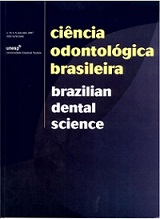Oral Health Longitudinal Evaluation of students from a public school after guidance and implementaion of preventitive measures
DOI:
https://doi.org/10.14295/bds.2012.v15i4.846Abstract
Objective: To assess longitudinally the DMFT, plaque and gingival rates of children and teenagers from a public school in São José dos Campos, Brazil, after performing a preventive and motivational program through the University Extension program of School of Dentistry of Institute of Science and Technology of São José dos Campos – UNESP. Materials and Methods: 300 students were randomly selected and divided into three groups, Group 1: 100 children from 2nd to 5th grade of elementary school, Group 2: 100 children from 6th to 9th grade of elementary school; Group 3: 100 teenagers from first to third year of high school. A questionnaire was used to evaluate knowledge about oral habits and general oral health of students. Clinical examinations were performed to assess the gingival, DMFT and plaque index in the initial time (t0), 1 year (t1) and 2 years (t2). The questionnaire and clinical examination results led to implementation of a scheme to promote oral health throughout the school years. The collected data were statistically analyzed. Results: Mean values for DMFT were: Group 1: t0 = 2.3 / t1 = 2.28 / t2 = 1.88, group 2: t0 = 1.81 / t1 = 1.56 / t2 = 1.51 and Group 3: t0 = 1.92 / t1 = 2.61/ t2 = 1.86; for dental plaque index: group 1: t0 = 3.83/ t1 = 2.62/ t2 = 2.30, group 2: t0 = 2.06 / t1 = 3.24 / t2 = 1.39; Group 3: t0 = 2.27 / t1 = 0.94 / t2 = 0.8, and the gingival index: group 1: t0 = 1.31 / t1 = 0.79 / t2 = 0.96, group 2: t0 = 1.27 / t1 = 0.84 / t2 = 0.38; group 3: t0 = 1.21 / t1 = 0.82 / t2 = 0.23. Conclusion: There was a significant decrease in all evaluated indexes after 2 years of program, confirming thus the importance of systematic implementation of preventive measures.
Downloads
Downloads
Additional Files
Published
How to Cite
Issue
Section
License
Brazilian Dental Science uses the Creative Commons (CC-BY 4.0) license, thus preserving the integrity of articles in an open access environment. The journal allows the author to retain publishing rights without restrictions.
=================




























